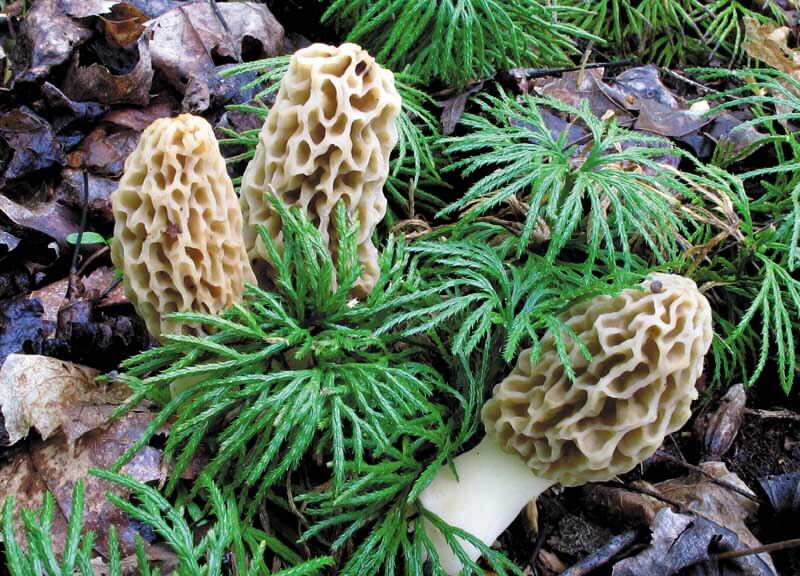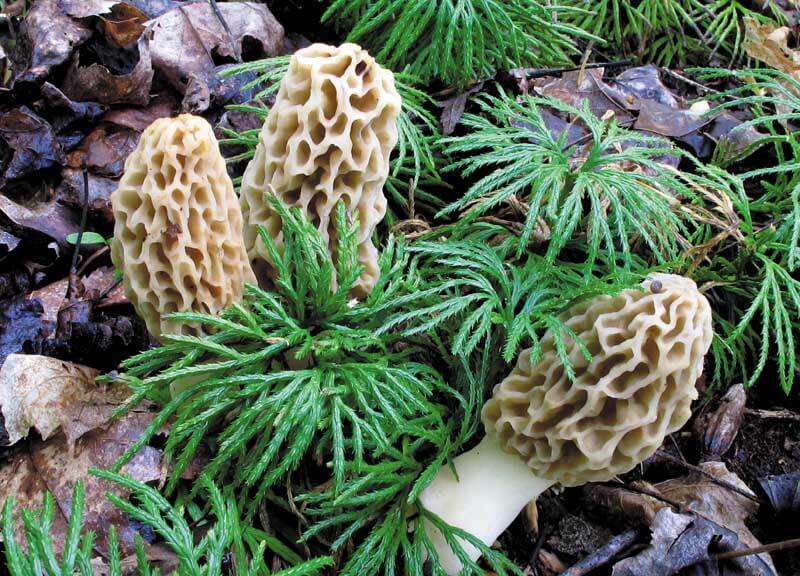
West Virginia is home to nearly 1,700 species of mushrooms and larger fungi—among them, the enigmatic morel.
Old growth forests are noisy this time of year. Emerging quickly from a monochrome blanket of snow and ice, the landscape seems to wake up all at once in a flash of green buds and birdsong. But while the pageantry of early spring in Appalachia is a sight to see, what’s going on just under the soil’s surface all year might be more important—at least to the health and vitality of the forests, says Bill Roody, seasonal biologist with the West Virginia Division of Natural Resources. “Think about it this way. Every year every acre of forest creates tons of debris. Dead leaves, branches, trees—all that falls to the forest floor. Yet our forests maintain their openness,” he says.
Somehow all that organic matter gets recycled and reused, ensuring a successful rebirth each spring. How? The hardwood trees in your area may reveal a clue. Often found poking through the leaf litter on the south-facing side of an old ash tree or tucked into the rows of a long retired apple orchard, mushrooms, or, more precisely, fungi, are the great recyclers of the ecosystem. These odd organisms can live thousands of years, can spread miles underground, and often enter into monogamous relationships to reproduce. Some mushrooms are edible, others are poisonous, and still others produce hallucinogenic effects in humans, but regardless, “they are extraordinarily important in the workings of the forest,” Roody says. “If it weren’t for the fungi, our forests would become impenetrable. Some fungi, like the morels you find in spring, also form symbiotic relationships with vascular plants like trees and release locked up soil nutrients—nitrogen, zinc, and phosphorus for example—that make new growth possible. They are beautiful objects, ecologically extremely interesting, and their biology is fascinating.”
Propped up on pale stalks with tall, deeply pitted caps in colors like gold, gray, and black, morels appear more alien than earthling. Despite their appearance, hundreds of mushroom lovers venture out from late March through May to gather and cook them. They are also some of the first mushrooms to appear after winter’s end. Over the years they’ve been called Molly Moochers, haystacks, hickory chickens, sponges, and even dryland fish, so named for their meaty texture and nutty flavor. They can be cooked into sauces and served on pasta, scrambled and fried with eggs, baked on pizza, or simply battered and fried—but like many wild mushrooms, experts agree they must always be cooked. Morels can cause stomach problems if eaten raw.
Dan Panaccione, Davis-Michael Professor of Plant and Soil Sciences at West Virginia University, says morels are unique not just because of their strange appearance. Their reproductive habits are a little unconventional in the myco-world as well. “Most mushrooms are monogamous,” Panaccione says. “You don’t think of mushrooms as having partners, but they often do. Most meet their partner early in life and they stay together for thousands of years and produce offspring like a couple.” But not the morel. “Morels stay single and hook up with many partners,” he says. And a single morel mushroom can release 250,000 to 500,000 microscopic spores.
“The mushroom you see on the ground, the morel that you might pick and eat, that’s only a very small part of the organism itself,” says Michelle Mabry, associate professor of biology at Davis & Elkins College and a curator of the state fungi collection, which houses just over 10,000 specimens. “I use the analogy of an apple on an apple tree. The mushroom is that reproductive structure. The rest of the organism is like the tree. The majority of the fungus is made up of little hyphae or filaments under the ground. They are microscopic, but they grow through the litter and, every now and then, they will pop up with a fruiting body. It’s why mushrooms seem to pop up out of nowhere. The fungus has been there the whole time. You just can’t see it.”
Roody says West Virginia, with 75 percent of its landscape forested and plenty of rainfall, is a prime habitat for mushrooms like morels—if you know where to look. “They can be found in quite an array of favorable places here. The classics would be old apple orchards and tulip poplar woods. For the black morel, the first that appear are most often under ash trees.” He says they’re also frequently found in burnt forests and under elms succumbing to Dutch elm disease, possibly because the fungi can sense the trees’ distress and are trying to ensure their own survival. “There are half a dozen species of morel, but they are all similar enough that people who know morels would recognize them.”
So unique in appearance, morels are often among the first mushrooms a novice hunter learns to identify. “Mushroom hunters tell me they learned to find them from their uncle or father or grandfather. It’s a traditional thing that gets passed down in West Virginia in particular,” Roody says. Still, he and other mushroom hunters stress caution for anyone looking to gather morels without proper training. In fact, there is at least one toxic species that resembles the morel. “This wariness is often taught from generation to generation,” he says. But don’t go asking a seasoned mushroom hunter for a detailed map to his favorite morel spots. “Hunters cherish these sites and don’t like to disclose them. Because once you have a site you can go back year after year.”
The mushroom you see on the ground, the morel that you might pick and eat, that’s only a very small part of the organism itself.
Michelle Mabry
associate professor of biology at Davis & Elkins College
Hailing from the Finger Lakes region of New York, Roody found few resources on mushrooms when he first settled in West Virginia decades ago, despite the state’s abundance of fungi. “When I started out studying mushrooms, there wasn’t much in the way of organization anywhere,” he says. “You kind of had to work on your own.” He began searching out all the books he could find, only a handful back then. But as mushrooms became more a part of the general culture, enthusiast clubs began to form. “I started joining them and going on these forays—organized mushroom hunts lasting as long as three or four days,” he says. “They would have lectures and people would go out by the busload to bring back specimens and have experts identify them and create exhibits. It was a very joyful process of learning.”
Today West Virginia has many resources for those who wish to learn more about mycology. In addition to the West Virginia Division of Natural Resources’ online resources and books like Roody’s 2003 guide Mushrooms of West Virginia and the Central Appalachians, mushroom hunters have the nonprofit West Virginia Mushroom Club. Open to experts and beginners alike, the club promotes interest in the study of fungi, from the massive puffball to the tasty oyster mushroom. It’s a place where enthusiasts can share their experiences and knowledge at lectures, forays, and cookouts while ensuring the art of the hunt and the passion for this humble organism is never lost. “Mycology is a field that isn’t as well-known as the other sciences,” Roody says. “But there’s a whole world to explore here.”
This story was originally published in the March 2015 issue of Wonderful West Virginia.
written by Mikenna Pierotti
photographed by Bill Roody

